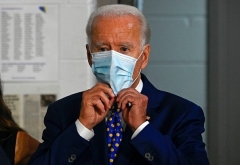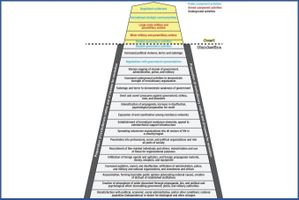
Democraic presidential nominee Joe Biden puts on a mask in Wilmington, Delaware in July. (Photo by Andrew Caballero-Reynolds/AFP via Getty Images)
(CNSNews.com) – Democratic presidential nominee Joe Biden said on Thursday night that he was wearing protective masks “from March on,” at a time when “the science” and experts like National Institute of Allergy and Infectious Diseases director Dr. Anthony Fauci were calling for such precautions against coronavirus infection.
In fact public health authorities in the U.S. only issued guidance recommending mask wearing in public on April 3, and the World Health Organization (WHO) held off on doing so until early June.
“From March on, I stopped doing big meetings, I started wearing masks, you know,” Biden said during an ABC News town hall in Pennsylvania. “It was at a time when the science was saying, and his key people, Dr. Fauci, was saying, you should be taking these precautions.”
Biden then went on to talk about the need for a “national standard” on mask wearing, and to criticize President Trump for leaving matters up to governors rather than taking responsibility.
“It’s the presidential responsibility to lead,” he said. “And he didn’t do that. He didn’t talk about what needed to be done, because he kept worrying, in my view, about the stock market.”
Despite talk by Biden and others about what “the science” was saying at the time, for months WHO experts and others argued that mass mask wearing would encourage a false sense of security while also depriving health staff treating COVID-19 patients of badly needed personal protective equipment (PPE).
A timeline of the evolving public health advice on mask wearing follows:
Mar. 1, 2020: The Office of U.S. Surgeon General Jerome Adams tweets: “Seriously people – STOP BUYING MASKS! They are NOT effective in preventing general public from catching #Coronavirus, but if healthcare providers can’t get them to care for sick patients, it puts them and our communities at risk!”
Mar. 4: WHO advice: “Use a mask only if you have respiratory symptoms coughing or sneezing, have suspected COVID-19 infection with mild symptoms, or are caring for someone with suspected COVID-19 infection.”
Mar. 8: Fauci tells CBS’ “60 Minutes”: “The masks are important for someone who is infected to prevent them from infecting someone else. Now when you see people and look at the films in China and South Korea, where everyone is wearing a mask, right now in the United States people should not be walking around with masks.”
Mar. 10: CDC National Center for Immunization and Respiratory Diseases director Nancy Messonnier tells a briefing, “We really do not think this is the time for Americans to be going out and getting masks. Masks are really important for those at highest risk in the health care setting … I ask people to please fight the urge to buy a mask and make sure we save them for the people that really need them.”
Mar. 15: WHO guidance: “If you are healthy, you only need to wear a mask if you are taking care of a person with suspected SARS-CoV-2 infection.”
Mar. 30: WHO emergency program director Dr. Michael Ryan: “There is no specific evidence to suggest that the wearing of masks by the mass population has any potential benefit. In fact, there’s some evidence to suggest the opposite in the misuse of wearing a mask property and fitting it properly.”
Mar 31: Surgeon General Jerome Adams tells Fox News, “If you’re sick, wear a mask. If you have a mask and it makes you feel better, then by all means wear it. But know that the more you touch your face the more you put yourself at risk. And know that right now the data isn’t quite there to say that there’s a net benefit to the individual of wearing a mask.”
Apr. 3: President Trump at a White House task force briefing announces new guidance that people in the U.S. should wear face coverings in public to slow the spread of the coronavirus, although he says he himself will not choose to do so.
Apr 4: CDC updates its guidance. In the light of new evidence relating to the possible transmission of the virus by asymptomatic carriers, “CDC recommends wearing cloth face coverings in public settings where other social distancing measures are difficult to maintain (e.g., grocery stores and pharmacies), especially in areas of significant community-based transmission.”
Apr 6: WHO guidance: “[T]he wide use of masks by healthy people in the community setting is not supported by current evidence and carries uncertainties and critical risks.”
May 28: Fauci says he now wears a mask in public as a “symbol” of what the public “should be doing,” while acknowledging masks are “not 100 percent effective.”
May 30: WHO guidance remains unchanged: “If you are healthy, you only need to wear a mask if you are taking care of a person with COVID-19.”
Jun. 5: WHO updates guidance: “Many countries have recommended the use of fabric masks/face coverings for the general public. At the present time, the widespread use of masks by healthy people in the community setting is not yet supported by high quality or direct scientific evidence and there are potential benefits and harms to consider.”
Jun. 5: WHO Director-General Dr. Tedros Adhanom Ghebreyesus tells a briefing, “In light of evolving evidence, WHO advises that governments should encourage the general public to wear masks where there is widespread transmission and physical distancing is difficult, such as on public transport, in shops or in other confined or crowded environments.”
Jul. 14: Fauci tells CBS Evening News anchor Norah O’Donnell he does not regret his early advice on masks, “because in the context of the time in which I said it, it was correct. We were told in our [White House] task force meetings that we have a serious problem with the lack of PPEs and masks for the health providers who are putting themselves in harm’s way every day to take care of sick people.”
Sept. 22: Fauci tells the Daily Show: “[W]hat has evolved now is that almost people take sides, like wearing a mask or not is a political statement, and that’s really very unfortunate – totally unfortunate – because this is a purely public health issue. It should not be one against the other.”



